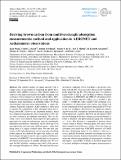Deriving brown carbon from multiwavelength absorption measurements: method and application to AERONET and Aethalometer observations
Author(s)
Wang, Xuan; Heald, Colette L.; Sedlacek, Arthur J.; de Sá, Suzane S.; Martin, Scot T.; Alexander, M. Lizabeth; Watson, Thomas B.; Aiken, Allison C.; Springston, Stephen R.; Artaxo, Paulo; ... Show more Show less
DownloadWang-2016-Deriving brown carbon from multiwave.pdf (3.018Mb)
PUBLISHER_CC
Publisher with Creative Commons License
Creative Commons Attribution
Terms of use
Metadata
Show full item recordAbstract
The radiative impact of organic aerosols (OA) is a large source of uncertainty in estimating the global direct radiative effect (DRE) of aerosols. This radiative impact includes not only light scattering but also light absorption from a subclass of OA referred to as brown carbon (BrC). However, the absorption properties of BrC are poorly understood, leading to large uncertainties in modeling studies. To obtain observational constraints from measurements, a simple absorption Ångström exponent (AAE) method is often used to separate the contribution of BrC absorption from that of black carbon (BC). However, this attribution method is based on assumptions regarding the spectral dependence of BC that are often violated in the ambient atmosphere. Here we develop a new AAE method which improves upon previous approaches by using the information from the wavelength-dependent measurements themselves and by allowing for an atmospherically relevant range of BC properties, rather than fixing these at a single assumed value. We note that constraints on BC optical properties and mixing state would help further improve this method. We apply this method to multiwavelength absorption aerosol optical depth (AAOD) measurements at AERONET sites worldwide and surface aerosol absorption measurements at multiple ambient sites. We estimate that BrC globally contributes up to 40 % of the seasonally averaged absorption at 440 nm. We find that the mass absorption coefficient of OA (OA-MAC) is positively correlated with the BC ∕ OA mass ratio. Based on the variability in BC properties and BC ∕ OA emission ratio, we estimate a range of 0.05–1.5 m[superscript 2] g[superscript −1] for OA-MAC at 440 nm. Using the combination of AERONET and OMI UV absorption observations we estimate that the AAE388∕440 nm for BrC is generally ∼ 4 worldwide, with a smaller value in Europe (< 2). Our analyses of observations at two surface sites (Cape Cod, to the southeast of Boston, and the GoAmazon2014/5 T3 site, to the west of Manaus, Brazil) reveal no significant relationship between BrC absorptivity and photochemical aging in urban-influenced conditions. However, the absorption of BrC measured during the biomass burning season near Manaus is found to decrease with photochemical aging with a lifetime of ∼ 1 day. This lifetime is comparable to previous observations within a biomass burning plume but much slower than estimated from laboratory studies. Given the large uncertainties associated with AERONET retrievals of AAOD, the most challenging aspect of our analysis is that an accurate, globally distributed, multiple-wavelength aerosol absorption measurement dataset is unavailable at present. Thus, achieving a better understanding of the properties, evolution, and impacts of global BrC will rely on the future deployment of accurate multiple-wavelength absorption measurements to which AAE methods, such as the approach developed here, can be applied.
Date issued
2016-10Department
Massachusetts Institute of Technology. Department of Civil and Environmental Engineering; Massachusetts Institute of Technology. Department of Earth, Atmospheric, and Planetary SciencesJournal
Atmospheric Chemistry and Physics
Publisher
Copernicus GmbH
Citation
Wang, Xuan, Colette L. Heald, Arthur J. Sedlacek, Suzane S. de Sá, Scot T. Martin, M. Lizabeth Alexander, Thomas B. Watson, Allison C. Aiken, Stephen R. Springston, and Paulo Artaxo. “Deriving Brown Carbon from Multiwavelength Absorption Measurements: Method and Application to AERONET and Aethalometer Observations.” Atmospheric Chemistry and Physics 16, no. 19 (October 13, 2016): 12733–12752.
Version: Final published version
ISSN
1680-7324
1680-7316